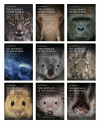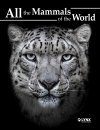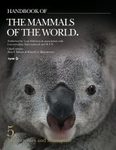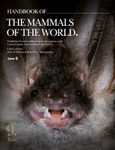About this book
Read our interview with the series creators
The Handbook of Mammals of the World (HMW) is an unprecedented, lavishly illustrated reference work for the Class Mammalia. This series of 9 large-format volumes describes and illustrates every currently recognized mammal species, along with a detailed overview of each mammalian Family. It provides up-to-date information on the evolutionary relationships, natural history, ecology, and current conservation status for all mammals. Every species is illustrated, and each Family Chapter contains beautiful color photographs of mammals in action. HMW provides comprehensive worldwide coverage by involving an international group of expert authors, each of whom is a leading authority on their respective groups of mammals.
An important driving force behind HMW is to support the conservation of mammals and their habitats, a task made easier through the involvement of Conservation International and IUCN (International Union for Conservation of Nature). A major aim of HMW is to illustrate the extraordinary diversity of mammals and to promote poorly known species, especially those in South America, Africa, and Asia, in the hope that this will inspire additional studies. The IUCN Red Data Books play an important role in conservation planning worldwide and highlight how little we know about the status of many mammalian species. An important contribution of HMW is to examine the status of every one of the world’s mammal species, describing the threats and outlining possible conservation measures.
HMW has followed traditionally accepted classifications, based on Mammal Species of the World (Wilson and Reeder, 2005). However, HMW has made several improvements. The views of the authors, all of whom are acknowledged authorities on their respective groups, have been incorporated into each volume. Each volume considers the description of new species and ongoing systematic revisions, which continue to add to our knowledge of the phylogenetic relationships within Mammalia. The section on Systematics within each Family Chapter reviews the on-going taxonomic work and recent research using new molecular techniques, which have revolutionized our ability to analyze evolutionary relationships.
Each chapter in every volume is dedicated to a Famlly of mammals. The Family Text gives a general overview of each family and includes numerous color photographs illustrating members of the family in action. This is followed by the individual Species Accounts, which are concise summaries of the known information from the primary literature. Both sections include an extensive bibliography.
In general, each volume presents the taxa in phylogenetic sequence, which reflects the evolutionary relationships as we currently understand them. The Family Texts are also amply illustrated with color photographs that not only depict as many species as possible, but also illustrate aspects of behavior or ecology that are mentioned in the text. Each Family Chapter includes a summary box providing a quick reference to the basic details of the family. Then, more detailed sections discuss Systematics, Morphological Aspects, Habitat, General Habits, Communication, Food and Feeding, Breeding, Movements, Home range, Social Organization, Relationship with Humans, Status and Conservation, and a General Bibliography listing the references used to compose the text.
There is a Species Account for each currently recognized species of mammal. All extant species are illustrated in the Plates, which show details of the pelage and general morphology. Each Species Account begins with the English Vernacular Name followed by the Scientific Name. Each species name is also given in French, German, and Spanish. Each Species Account summarizes everything known about Taxonomy, Subspecies and Distribution (with a distribution map), Descriptive Notes, Habitat, Food and Feeding, Activity Patterns, Movements, Home Range, Social Organization, Status and Conservation, and a Bibliography.
Handbook of the Mammals of the World, Volume 1: Carnivores deals with the following families: African Palm Civet; Cats; Linsangs; Civets, Genets and Oyans; Hyenas; Mongooses; Euplerids; Dogs; Bears; Red Panda; Racoons; Skunks; Weasels, Martens, Polecats, Badgers and Otters.
Handbook of the Mammals of the World, Volume 2: Hoofed Mammals reveals the family Bovidae in all their fascinating detail, in riveting accounts written by some of the most renowned authorities in the world. The species accounts supply complete and up-to-date information at a time when new and increasingly sophisticated methods of DNA analysis are reshaping our knowledge of these species; to give just one example, the family Bovidae has almost doubled its size in the last five years, to the 279 distinct species known today.
Handbook of the Mammals of the World, Volume 3: Primates counts more than 470 of them: 138 species of prosimians – the lemurs, lorises, pottos and tarsiers in Africa and Asia; 157 species of monkeys in the New World tropics; another 158 monkeys in the Old World tropics; and 25 apes, 19 of them gibbons along with six chimpanzees, gorillas and orangutans. Much of this extraordinary diversity has been discovered only in the past two decades. In the 1980s the count was 180 species. Now we know so much more of their diversity, and Handbook of the Mammals of the World, Volume 3: Primates presents them in all their remarkable variety of shapes, sizes, colours, habits and specializations.
Handbook of the Mammals of the World, Volume 4: Sea Mammals provides complete accounts of all species and families in these important groups. Large, majestic whales and stunning, playful dolphins have provided mysterious companionship to humans at sea for hundreds of years. These magical creatures, along with their equally fascinating relatives, the seals and sea lions, have developed a completely different set of adaptations from their terrestrial ancestors and relatives. Lavishly illustrated with colour photographs showing different behaviours of all of them, the text contains the latest up-to-date information on all families of sea mammals.
Handbook of the Mammals of the World, Volume 5: Monotremes and Marsupials provides complete accounts of all monotremes and marsupials. These include a host of animals that have intrigued mammal fanciers for centuries, such as Platypus, Echidnas, Opossums, Kangaroos, Koalas, Wallabies, and Wombats. Monotremes are a very distinctive ancient group of mammals with only a handful of extant species in Australia and New Guinea and marsupials, with roots in South America, likely reached Australia via Antarctica some 50 million years ago. With relatives remaining in America, Marsupials have adapted to an amazing diversity of lifestyles and habitats. Volume 5 of HMW provides complete coverage of these two important groups of mammals. Lavishly illustrated with colour photographs showing different behaviours of all of them, the text contains the latest up-to-date information on all families of Monotremes and Marsupials, both Australasian and American.
Handbook of the Mammals of the World, Volume 6: Lagomorphs and Rodents I includes all of the families of rodents other than Cricetidae and Muridae, plus the order Lagomorpha, which includes rabbits and pikas. This radiation includes some 35 families, which have spread around the globe, occupying every continent except Antarctica, and countless islands in all major oceans. As usual, the text includes up-to-date information on every species, and each species is illustrated. Each family account includes colour photographs documenting a variety of behaviours of these diverse and interesting mammals.
Handbook of the Mammals of the World, Volume 7: Rodents II completes the order Rodentia – which represents arguably the most important order of mammals, both in terms of number of species, and in geographic distribution – covering the families contained in the suborder Myomorpha, including the two largest families, Cricetidae and Muridae.
Handbook of the Mammals of the World, Volume 8: Insectivores, Sloths and Colugos covers all of the remaining orders (Cingulata, Pilosa, Afrosoricida, Macroscelidea, Scandentia, Dermaptera, and Eulipotyphla), other than bats (Chiroptera). From armadillos, sloths, and anteaters to shrews and moles, Volume 8 includes a wide variety of interesting small or medium-sized mammals from around the world. Most of them have different kinds of invertebrate and insectivorous diets, except sloths and colugos, which are arboreal herbivores and folivores.
Handbook of the Mammals of the World, Volume 9: Bats concludes the series and covers the bats (Chiroptera), Our knowledge of bats has exploded in the past two decades, and all of that information is reflected in this volume. The number of recognized species has increased by more than 400 during that time and is still growing. Bats occupy almost every habitat on six continents and their ecology is incredibly diverse. Pollinators and seed dispersers for thousands of species of plants, bats are critical for the maintenance of tropical ecosystems.
Customer Reviews































![How to Find and Identify Mammals [Revised Edition]](http://mediacdn.nhbs.com/jackets/jackets_resizer_medium/21/210208.jpg?height=150&width=106)











